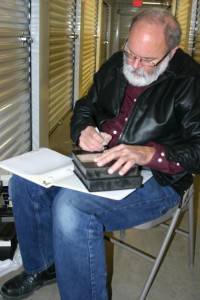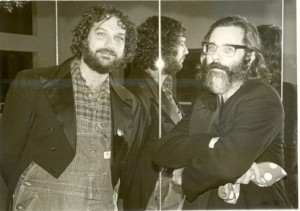Since its inception in 2009, Kickstarter has become one of the most popular methods of raising capital for artistic endeavors. Filmmakers and musicians often rely on the website to fund their latest projects.

Here’s how it works: An artist determines how much money he or she will need to get a project off the ground, sets a monetary goal, and describes the project on the Kickstarter website. A time limit is set, usually a period of 90 days. People pledge money. If the amount pledged reaches the stated goal in the allotted time frame, the artist gets all the money. But there’s a catch: If donations fall short of the goal, even by a dollar, the artist gets nothing. It’s a gamble. Set the goal too low, and you won’t raise enough money for your project. Set it too high, and you risk falling short and getting nothing.
So my jaw dropped when Bruce announced his Kickstarter campaign’s goal of $27,500. Most successful Kickstarter efforts set financial goals between $1,000 and $10,000. Hip Pocket fans are loyal but not exactly staggering in numbers or wealth. Donations slowly trickled in but stalled around the halfway point.
Lake Simons, a frequent actor and director at the theater, launched a Facebook campaign to spread the word. Bruce posted regular updates on his own Facebook page and on the Kickstarter page, urging people to help him create something special.
“The next eight to 10 days will tell the story,” he wrote on Nov. 13 when the campaign was still struggling at the midway point. “If we see some surges here and there –– pledges of varying levels –– that get us up above the $20,000 mark, then the momentum will start to appeal to some of the deeper pockets, and we should get where we need to be before time runs out.”
It took almost every minute of the 90 days, but 178 backers finally pushed the pledges past the goal on Dec. 4. Grand total: $28,060. Most donors contributed $100 or less, but 11 people gave $500, and nine people donated $1,000 each.
The older Balentine brother, something of a Renaissance man, has the skills to pull off the project. He’s an author, computer whiz, and sound technician who now works as chief scientist and executive vice president at Enterprise Integration Group, a technology consulting firm in Zurich. A year from now, he expects that 25 to 30 Simons-Balentine shows from the 1970s and ’80s (video and audio) will be available on a website, along with “early homemade tapes, garage recordings, and the visual reference material that goes with them.”

He spent several days last week in Fort Worth going through Welsh’s storage unit and talking with local tape-duplicating companies. Bourdage and Kirby have begun inventorying the material. They’ve established a library-like checkout system to keep track of all the tapes while they’re being transferred to digital format.
“I’ve got in this database all the plays, who acted in them, who directed, who wrote it,” Bourdage said, sitting outside the storage-unit door with a laptop on his knees and a stack of videos at his feet.
The project could have easily topped $100,000 in costs if not for volunteers such as Bourdage and Kirby, Bruce Balentine said. Various theater supporters will ultimately volunteer hundreds of hours of time to help finish the project by December 2014.
“That’s why we had to get it funded,” Balentine said. “It’s too much work for us all to do in our spare time.”
Thanks to volunteers, the labor will be free. The Kickstarter money is paying the cost of duplicating the tapes, putting all the various formats onto DVDs so they can be easily uploaded.
Spending hours digging through the old tapes on a recent Sunday morning cast a nostalgic spell over Balentine, Bourdage, and Kirby. The temperature was barely above freezing, and they remained bundled up in their coats and scarves while digging through the piles. Each hand-scrawled title sparked memories, and the three reminisced about actors, scenes, audience reaction, costumes, and music.
“If we can find the dance from Sex Kittens Go to College, that would be wonderful,” Bruce said. “It’s an especially good number.”

Bourdage picked up an ancient-looking reel holding a 2-inch tape. The box’s label described it as a Jonathan Winters promotional ad from the 1960s recorded at Channel 39 in Dallas. Nearby, Bourdage saw a reel of 3/4-inch tape and another with half-inch tape. Each would require a different duplicating machine to reveal the footage. Despite the amount of time required to complete this maze of work, all three volunteers worked with smiles on their faces and excitement about finally getting the project started.
“We’ve got to build a website,” Bourdage said. “That’s where a lot of the money is going to go ultimately.”
One thing’s for certain –– nobody is just flapping their jaws. Bruce Balentine’s project outline could match that of the Normandy invasion. Even his recent trip to Fort Worth to pore over the storage unit was preceded by an exhaustive schedule that accounted for his every waking hour while he was in town. It gives confidence to Kickstarter donors and inspires gratitude in Johnny Simons, the heart and soul of Hip Pocket. Simons loved Balentine like a brother and takes satisfaction in knowing that his lost friend’s work will be saved for the ages.
“Bruce has ramrodded this whole project,” Simons said. “Without his enthusiasm and energy, it would have never gotten off the ground.”
And there could be more. If donations continue to trickle in, Balentine plans to use the extra money to commission an original play, penned by Simons, to complement the archived material and demonstrate “the ongoing vitality and creativity of live original theater in Fort Worth,” he said.












Fantastic article, Jeff! The true contribution of Johnny Simons and company to world culture will not be felt in our lifetime, but just like the initial obscurity of Rembrandt, J.S. Bach, Walt Whitman, Emily Dickinson, Van Gogh, Nick Drake, etc., their relative importance will grow exponentially as the years go by until taking their rightful place alongside the greatest repertory groups and theatrical canons of all time (a la Shakespeare’s and Bertolt Brecht’s), validated, I imagine, by dozens of college dissertations; and this preservation project will insure it. To my way of thinking their outdoor stage west of interstate 820 is a sacred space on the order of Chartre Catheral, The Dome of the Rock, or Stonehenge, all of which I’ve experienced and which induce the same goosebumps in me as a night under the stars at the Hip Pocket Theater. Fort Worth won’t know what it’s got till it’s gone. But that’s okay, now that good digital record of it will exist.
great piece, important collection effort. Hip Pocket fan from way back! Thanks, Jeff.
Who is “Bob Bourland” in the photo captions? Shouldn’t it be “Bob Bourdage”?